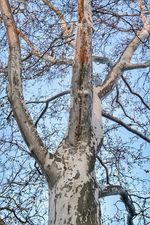- Visit
- Things to Do
- Learn
- Arboretum
- Research
- Support
- About
- People

The State Arboretum of Virginia Names the 2022 Tree of the Year: American Sycamore
On Arbor Day, April 29, the State Arboretum honors one of the largest trees in the eastern U.S. with a planting at Blandy Experimental Farm
Representatives from the State Arboretum of Virginia at Blandy Experimental Farm have named the majestic American Sycamore (Platanus occidentalis) as the 2022 Tree of the Year. Since 2019, the State Arboretum of Virginia has designated one extraordinary species of tree as its Tree of the Year.
In honor of Arbor Day, “the nation’s tree planting holiday,” Blandy arborists and representatives from the Department of Forestry will plant an American Sycamore tree at the Arboretum on Friday, April 29. The tree will be added to a tree and shrub collection that dates to the 1930s.
The Arboretum’s 2022 Tree of the Year was selected after deliberation by Curator T’ai Roulston and Blandy arborists.
“A vital part of our mission is to practice and promote tree education, science, and conservation,” said Roulston. “Through research and public programming, we want to share with everyone – of all ages – how important trees are to the environment.”
According to Roulston, the sycamore was selected for its value as one of the largest trees in the eastern U.S. and for its exfoliating bark which creates a beautiful, mottled layer of light greens, grays, and browns.
The American Sycamore is a massive tree, with heavy, spreading branches that can grow to a height of 70-100 feet with a canopy spread of 60-80 feet. Its leaves, which often measure up to eight inches across, help make the sycamore one of our most impressive shade trees.
Sycamores are also called buttonwood or buttonball trees because of the one-inch balls that hang from the tree through the winter months and then fall each spring.
Sycamore is a large deciduous species of wide distribution across the eastern and central U.S. and is used for lumber and pulpwood. Sycamore seeds are eaten by wildlife, and its hollowed limbs are often used as nesting sites for birds and mammals. In the wild, it is most often found in riparian areas, but as a cultivated tree it can grow well in upland sites. It is often used as a street tree, sometimes forming an impressive allée – a tunnel of green lined with streaked white trunks. The downtown area of our local city of Winchester gets much of its natural grandeur from these massive trees.
In 1744, a Shenandoah Valley settler named Joseph Hampton supposedly lived with his two sons for most of the year in a hollow sycamore in Clarke County, VA. And in 1770, while surveying for the Kanawha Canal, George Washington recorded in his journal a sycamore tree with a trunk that measured almost 45 feet in circumference.
This is Blandy’s fourth pick for Tree of the Year. Past Trees of the Year include:
2021: Pawpaw (Asimina triloba)
2020: Sassafras (Sassafras albidum)
2019: Eastern Redbud (Cercis canadensis)
On Arbor Day each year, the State Arboretum of Virginia honors one extraordinary species of tree as its Tree of the Year. The goal of the program is five-fold:
- To remind us of the value and environmental significance of trees in Virginia and beyond
- To educate the public about the variety of trees in Virginia
- To nurture a love of trees in all ages
- To promote important tree education, science, and conservation at the State Arboretum and elsewhere in Virginia
- To join with others in awe of the majesty of Virginia’s tree
In selecting the Tree of the Year, these key traits are considered:
- Does the tree have a compelling story or uniqueness? Does it have special characteristics – for example, color or leaf structure – that make the tree an interesting choice?
- Is the tree readily available for purchase in Virginia at most nurseries?
- Is the tree familiar to most gardeners?
- Is the tree easy to grow and nurture for nonprofessionals and will make a good addition to a residential landscape?